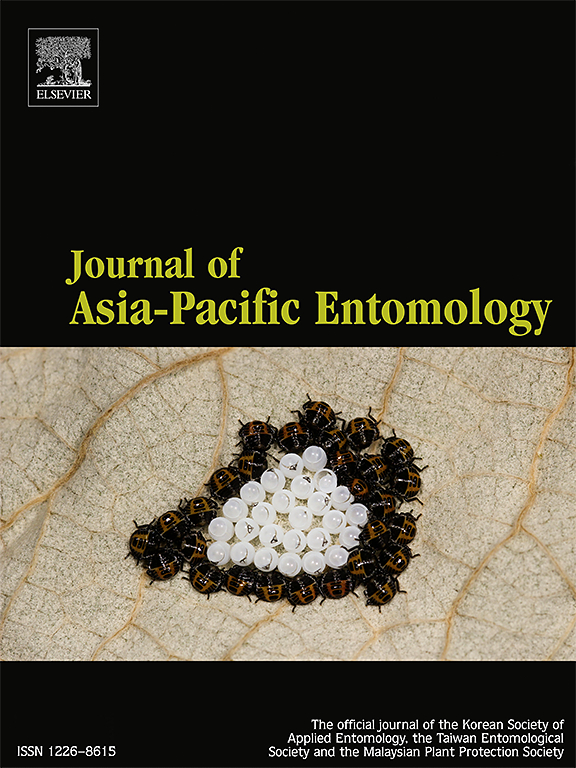卫生条件解释了小菜蛾在充足食物条件下的幼虫密度依赖性表现
IF 1.3
3区 农林科学
Q3 ENTOMOLOGY
引用次数: 0
摘要
幼虫密度是影响昆虫生长发育和种群动态的重要因素。在食物资源有限的条件下,较高的幼虫密度会导致个体食物供应减少,从而造成不良后果。在食物充足的情况下,幼虫密度对昆虫生产性能的影响及其潜在机制尚未得到充分的研究。在不同的饲养密度(1、4、7和10只幼虫/培养皿)条件下,对小菜蛾(鳞翅目:小菜蛾科)的适合度性状进行了比较。每箱饲养10只小菜蛾的蛹重、实现繁殖力和成虫寿命均显著低于低密度饲养的小菜蛾。为了找出潜在的机制,我们进一步验证了卫生条件在一定程度上影响幼虫在充足食物条件下的密度依赖性表现的假设。研究了在相同饲养密度(每培养皿10只幼虫)条件下,在充足的白菜叶条件下,3种卫生条件(清洁、对照、杂乱:以粪便积累率表示)对小菜蛾适合度的影响。结果证实了卫生条件在调节幼虫适合度对幼虫密度的响应中起重要作用,与清洁条件相比,肮脏条件显著降低了蛹重、总存活率、实现繁殖量、成虫寿命和完成一个生命周期的发育率。这些发现强调,即使有足够的食物,在不同的密度和卫生条件下饲养昆虫也会在很大程度上影响健康结果。这为理解高密度昆虫捕食的生态学提供了重要的见解。本文章由计算机程序翻译,如有差异,请以英文原文为准。

Hygiene conditions explain larval density-dependent performance in Plutella xylostella with sufficient food
Larval density is an important factor influencing insect growth, development and population dynamics. Under conditions of limited food resources, higher larval density leads to reduced food availability per individual, causing adverse outcomes. When food was abundant, how larval density influences insect performance and its underlying mechanism have been understudied. We compared fitness traits of Plutella xylostella (Lepidoptera: Plutellidae), over a wide range of rearing densities (1, 4, 7 and 10 larvae per Petri dish) provided with sufficient common cabbage leaves. Plutella xylostella reared at 10 larvae per container had significant reductions in the pupal weight, realized fecundity, and adult life span when compared with those reared at lower densities. To find out the underlying mechanism, we further tested the hypothesis that the hygiene condition in part mediates larval density-dependent performance of larvae with sufficient food. We investigated the effect of 3 hygiene conditions (clean, control, mess: indicated by feces accumulation rates) on fitness of P. xylostella at the same rearing density (10 larvae per Petri dish) provided with sufficient common cabbage leaves. Results confirmed the important role of hygiene conditions in mediating the responses of larva fitness to larval density that the mess condition significantly reduced the pupal weight, total survival rate, realized fecundity, adult life span, and the development rates of completing a life cycle in comparison to cleaner treatments. These findings highlight that, even with sufficient food, rearing insects in different densities and hygiene conditions can largely affect the fitness outcomes. This provides critical insights for understanding the ecology of insects feeding in high densities.
求助全文
通过发布文献求助,成功后即可免费获取论文全文。
去求助
来源期刊

Journal of Asia-pacific Entomology
Agricultural and Biological Sciences-Insect Science
CiteScore
2.70
自引率
6.70%
发文量
152
审稿时长
69 days
期刊介绍:
The journal publishes original research papers, review articles and short communications in the basic and applied area concerning insects, mites or other arthropods and nematodes of economic importance in agriculture, forestry, industry, human and animal health, and natural resource and environment management, and is the official journal of the Korean Society of Applied Entomology and the Taiwan Entomological Society.
 求助内容:
求助内容: 应助结果提醒方式:
应助结果提醒方式:


